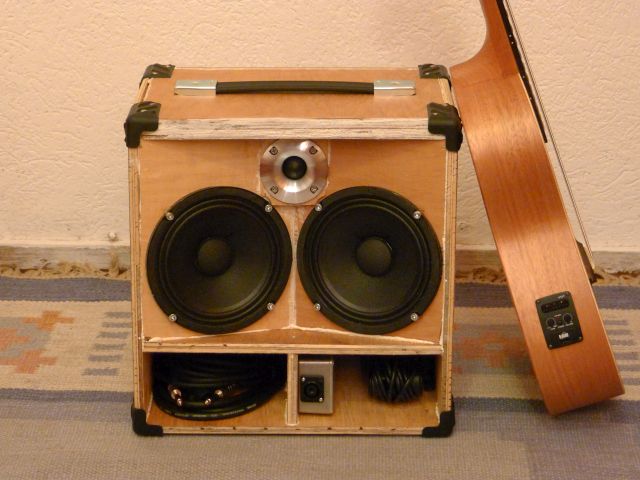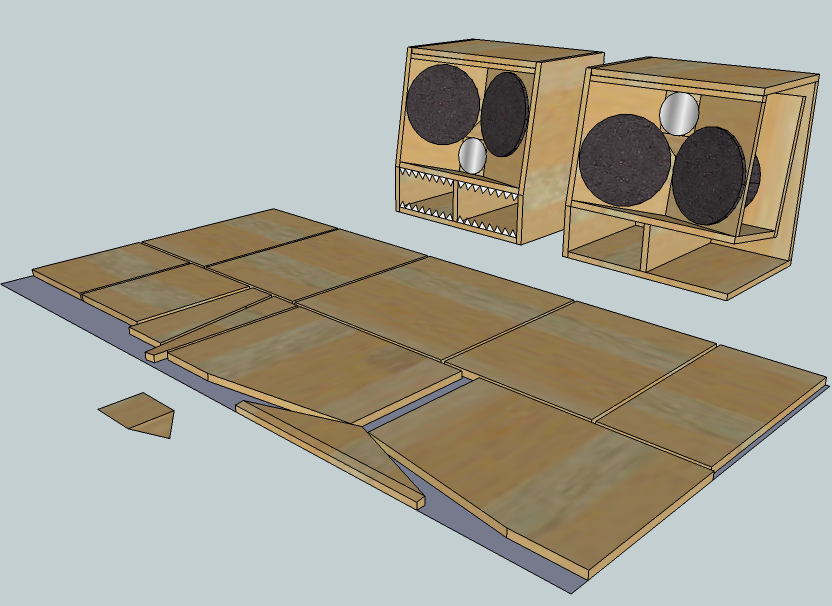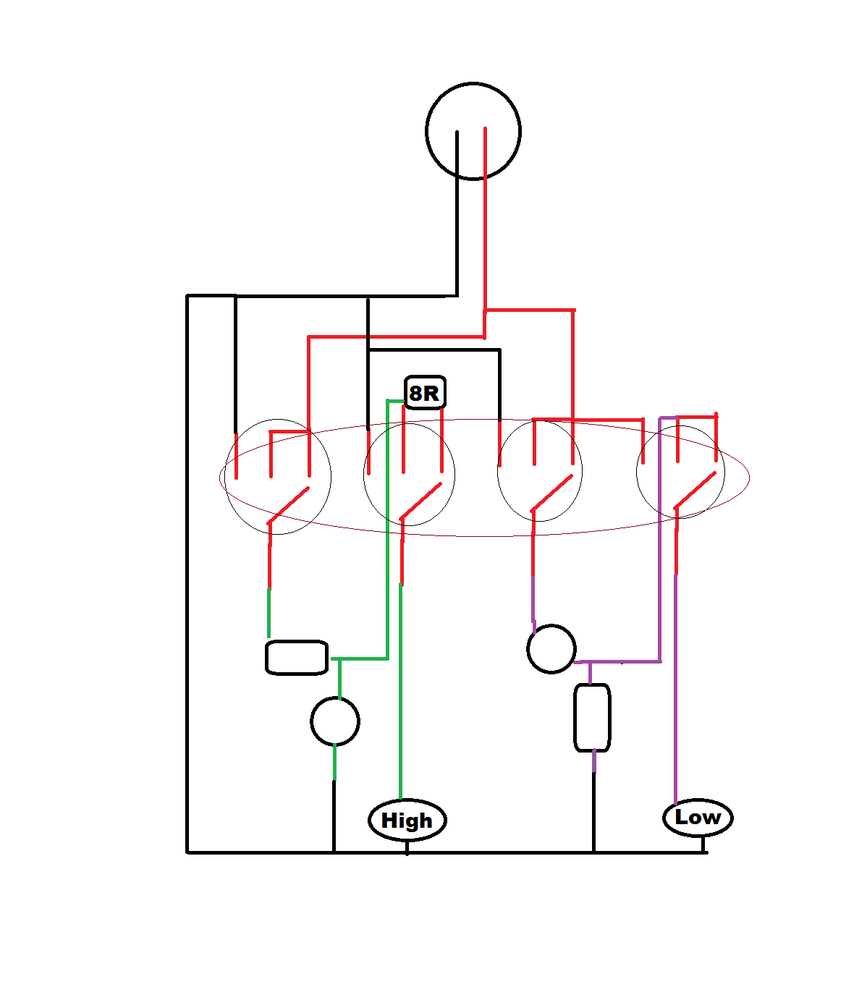January 2015, text/instructions from back then too. I’m a little sad that I mounted the tweeter up top, and not in the middle as a “nose” with little teeth as drawn as an option in the cutsheet picture. Still, I love how it sounds for bass guitar. Still a great practice amp, only thing I changed since 2015 is put little wheels under it. Might one day make it active by putting a plate amp in the back.
2x Fane Sovereign 6-100, 1x Mivoc XGH 258 ALU
4 ohm, 96 dB/W, 200W RMS, -3dB @ ~75Hz
Passive crossover @ 2550Hz (with switch)
25x35x35cm, 8.4kg
For this 2×6″ top cab, I was mainly inspired by Arjank’s Piccolo8 horn reflex cab, since I really liked the clarity of bass lines on my small horn reflex bookshelf speakers. I was also inspired by greenboy’s cabs that have 6″ mids and a tweeter as a vital part of the sound. I was also inspired by Bill Fitzmaurice’s XF guitar cabs that mount two speakers in a cross-firing position and with a rear tilted baffle. I designed the cab using Hornresp. When I’d finished it, it was a bit peaky in the 100-300Hz region but after stuffing the driver volume it sounded a lot better.
At practice volume, the 2×6″ goes low enough on its own. Over ~40W, I needs a high pass filter >150Hz to keep from farting out (xmax) and I add one or two of the TH cabs.

— Wood —
This design uses 12mm plywood. If you are REALLY careful, you can cut all but
the tweeter baffle from a quarter sheet (1220x610x12mm). See the cut sheet in
the Sketchup file.
The entire driver enclosure is tilted backward 9 degrees compared to the horn
port. The two 6″ drivers are crossed inward at 20 degrees each. NOTE: the two
baffle pieces, the piece at the top of the baffle and the top part of the cab
therefore have a few 9 or 20 degree cut angles that you should not overlook!

— Drivers —
This design uses two Fane Sovereign 6-100 6″ drivers. The volume behind the
drivers and the length of the horn are based on Hornresp simulations of the
frequency response of the cab with these particular drivers in it. Using
different drivers will have a very big impact on the frequency response of
the cab; you will probably get a big thump around 150Hz and not much response
in the frequencies below that. At the bottom of this file, you will find the
Hornresp values that I used if you wish to try modelling different drivers.
That said, the tweeter (Mivoc XGH 258 ALU) could be replaced by a different
model or even omitted. If you go for a different model tweeter, you may need
to change the crossover.
My cab benefitted a lot from stuffing the volume behind the drivers with the
insides of a pillow. You could also use actual BAF wadding or wool, and/or
line the inside with felt. This will help dampen unwanted sound reflections.

— Crossover —
The crossover that I used is a simple passive second order crossover around
2550Hz. The woofers have a combined impedance of 16 ohms around this
frequency and the tweeter as well. I used a 3.9uF capacitor and a 1.0mH
inductor for both the low pass and the high pass sieds. Make sure the
capacitor is bipolar and the inductor is of reasonably low resistance. I am
new to crossover design though so I’m sure there are better ways to go about
it.
— Crossover switch —
If you want to be able to switch between running the 6″ drivers full range,
or adding the tweeter via the crossover, use a rotary switch. I’ve used a
4P3T rotary switch that in the third switch position adds an 8 ohm resistor
in series with the tweeter. This pads the tweeter a bit, but it also changes
the crossover point slightly so this is not the best way to pad the tweeter.
I mounted the rotary switch in the horn mouth, where you can easily access
it.

— Using the cab —
If you use the cab on its own, note that it will fart out if you push more
than approx. 40W into it. If you wish to get more output, you can add a high
pass filter and cross over the lower frequencies to a different cab. That
way, the cab can handle about 200W. I use a tapped horn cab crossed over to
the 2×6″ cab around 175Hz. The TH design that I used (THAM10) is freely
available on the website of Anders Martinsson, the designer, at
http://www.martinsson.cc/
— A suitable amplifier —
If you wish to make the cab into a combo, or just want to have a small amp
for it, I recommend looking into the TPA3116D2 amplifier. You can order a
board cheaply from China (<$20) and its output is perfect for this cab. If
you use a 19V laptop power supply, it can push about 35W into the cab at
below 0.1% distortion. With a 24V power supply you could get about 60W out
of it. If you run in PBTL mode, it is 2 ohm stable and you could get up to
100W if you add another cab.
You can set the gain at either 20, 26, 32 or 36 dB. With both pickups at
100% on my jazz bass, I found that the gain was enough to practice without a
preamp, but I recommend setting the gain to 32 if you have a passive bass
and will not be using a separate preamp. More on this amp at diyAudio here:
http://www.diyaudio.com/wiki/TPA3116D2_Boards
— Hornresp input data —
Ang 2.0 x Pi
Eg 2.00
S1 70.00 S2 280.00 Con 47.00
Sd 139.20 Cms 8.00E-05 Mmd 23.94 Re 6.90
Bl 13.25 Rms 1.35 Le 1.15 Nd 2P
Vrc 0.00 Ap 255.00 Vtc 8500.00
Lrc 0.00 Lpt 0.00 Atc 500.00